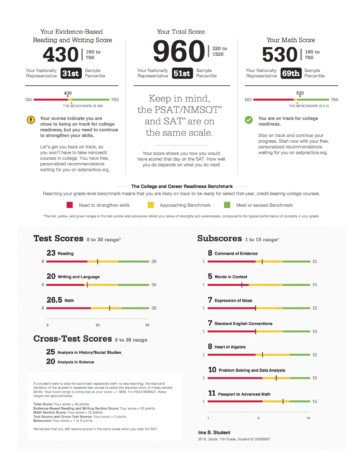PSAT Score Range: What Does My PSAT Score Mean?

For many students nationwide, the PSAT is your first introduction to College Board standardized testing. Although you have probably sat through numerous standardized tests throughout your education up until this point, this is the first time that you are taking a test designed specifically to assess your progress towards college-readiness. This may seem like an intimidating prospect, but don’t let it get in your way.
The PSAT is actually meant to provide you and your teachers with more information about your knowledge and, by doing so, provide direction for your future education. These scores can affirm your areas of strength and draw attention to areas that need more reinforcement, practice, or attention before you’re ready for college.
Your PSAT scores, while important indicators of your progress, are not ultimately a part of your college application, unless you happen to do so well that you earn yourself a scholarship. So, while it can seem stressful to take the PSATs, it’s helpful to think of your PSAT score as something that, at the very least, can’t do any harm.
Introduction to the PSAT
What is the PSAT?
There are three versions of the PSAT, with two versions designed uniquely for high school students and the third, the PSAT 8/9, a crossover test designed for both eighth- and ninth-graders. The PSAT 10 is designed for students in grade 10, or students in their second year of high school studies, and the PSAT/NMSQT is designed for students in their junior year, who are one year away from high school graduation.
The PSAT/NMSQT, taken by approximately 3.4 million students each year, is also known as the National Merit Scholarship Qualifying Test. To learn more about it, read CollegeVine’s How to Qualify for the National Merit Scholarship Program.
What Does the PSAT Assess?
Beyond its use as a scholarship-qualifying test, the PSAT/NMSQT and PSAT 10 both assess the knowledge you’ve gained so far in high school and give you a good idea of what you’ll need to succeed in college. As the College Board puts it, the PSAT measures the “knowledge, skills, and understandings that research has identified as most important for college and career readiness and success.” Specifically, it measures your skills in math, reading, and writing.
Why Should I Take the PSAT?
The PSAT aims to give you a better understanding of your readiness for college. It also provides access to scholarships and is a great way to begin practicing for the SAT. Even if you don’t qualify for one of the available scholarships, the experience and knowledge you gain by taking the test are valuable on their own.
PSAT Scores
How Are PSATs Scored?
The PSAT is scored in the same way that your SAT ultimately will be, should you choose to take one. Because the test consists only of multiple-choice questions, a computer is used to scan your answer sheet and count the number of correct answers in each section. This produces a raw score, which is simply the number of questions you got right.
Your raw score is then converted to a scaled score between 160-760 for each section. This process is called equating and it accounts for very slight differences in difficulty between various versions of the test, ensuring that the level of knowledge required to achieve a specific score on one version of the test is exactly the same as on another version of the test.
Interpreting Your Score Report
Your PSAT score report provides you with a lot of valuable information, beyond simply a number score. In order to really dig into that information, you’ll need to start with a general understanding of the numbers on your score report.
The first number you’re likely to see on your score report is your Total Score. This ranges from 320-1520 and is calculated simply by adding together your section scores. Your Section Scores, which you’ll see on either side of your total score, represent your equated scores on a scale from 160-760 for the Math Section Test and the Evidence-Based Reading and Writing Section Test. Your total score and section scores are the ones most commonly used to qualify you for scholarships.
Your score report does not end with these numbers, though. You will also see numbers between 8-38 for individual Test Scores (basically, subsections of the above Section Scores that include Reading, Writing and Language, and Math) and for Cross-Test Scores, which are calculated by totaling questions pertaining to History/Social Studies and Analysis in Science, as they are spread across the test.
Finally, you will see Subscores ranging from 1-15 for a number of skill sets. These scores indicate how you performed on questions related to these skills, regardless of which test section the specific question was included in. The skills include Command of Evidence, Words in Context, Expression of Ideas, Standard English Conventions, Heart of Algebra, Problem Solving and Data Analysis, and Passport to Advanced Math. This section of your score report is particularly helpful for guiding your future studies, since it easily highlights areas of strength and areas in need of further practice.
Percentiles
Beneath your total score and your section scores, you will see a percentile ranking. This number shows how you scored compared to other students. It represents the percentage of students whose scores fall at or below your score. For example, if you score in the 75th percentile, your score is higher than 75% of your peers taking the test.
College Readiness Benchmarks
On your score report, you will see your scores placed on a color-coded continuum representing benchmark scores. These benchmarks are provided in order to identify students who are on track for success in college-readiness and to identify students who may need extra support while there is still time to provide it. The College Board specifically warns that benchmarks are not good indicators of appropriate academic tracks so, even if you do not meet the benchmarks, you should not be discouraged from taking the SAT, applying to college, or participating in challenging courses.
Instead, reaching your grade-level benchmark means that you are likely on track to be ready for select first-year, credit-bearing college courses. The current PSAT Evidence-Based Reading and Writing benchmark score is 460. The current PSAT Math benchmark score is 510.
Benchmarks are also provided for each of your Test Scores and each of your Subscores. They are color-coded according to the following designations:
- Green: Your score meets or exceeds the benchmark.
- Yellow: Your score is approaching the benchmark.
- Red: You need to strengthen skills in this area.
Don’t be overwhelmed by all these numbers. The actual score report that you receive will present this information in a visually cohesive format. See the example from the College Board below to get a better idea of what an official score report looks like, or view an entire sample score report for the PSAT/NMSQT or PSAT 10.
Who Can Access My PSAT Scores?
Who can access your PSAT scores is partially up to you. In all cases, you will be able to access them and your high school will be able to access them. Additionally, if you are a junior taking the PSAT/NMSQT, the National Merit Scholarship Corporation, a cosponsor of the test, will be able to access your scores. Beyond that, in some cases your district or state will also have access to your scores.
Your scores will also be released to select scholarship organizations. These include the National Hispanic Recognition Program, the National Scholarship Service, and Telluride Seminar Scholarships. Although this is standard practice, you do not have to allow your scores to be released to these organizations if you do not want them to be. If you do not want your scores released to these organizations, you will need to write to the PSAT/NMSQT program by Oct. 31 at this address:
P.O. Box 6720
Princeton, NJ 08541-6720
On the day of your PSAT test, you are also given the opportunity to share information about yourself through the College Board’s Student Search Service. This service provides information about you to colleges and scholarship programs, who might contact you by mail, email, or telephone. This program does not provide your specific test scores to these programs.
As with any time that you are asked to give out your personal information, you should discuss this decision ahead of time with a parent or guardian, so that you know in advance whether you’ll be opting in or out of this program. Your decision will bear no weight on your scores or your eligibility for the scholarships listed above, to which your scores are released unless you write a letter requesting otherwise.
How Should I Use My PSAT Scores?
Your PSAT score can help you understand where you need to focus to prepare for the SAT. Use your score to build an SAT study plan focused on improving your areas of weakness.
Preparing for the SAT? Download our free guide with our top 8 tips for mastering the SAT.
To learn more about the PSATs and SATs, check out these CollegeVine posts:
Want to know how your SAT score/ACT score impacts your chances of acceptance to your dream schools? Our free Chancing Engine will not only help you predict your odds, but also let you know how you stack up against other applicants, and which aspects of your profile to improve. Sign up for your free CollegeVine account today to gain access to our Chancing Engine and get a jumpstart on your college strategy!




